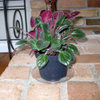Pearcea hypocyrtiflora
bubba62
15 years ago
More Discussions
I purchased a beautiful Pearcea hypocyrtiflora early last fall and have been attempting to grow it under lights in a large paludarium (a 45 gallon aquarium containing about 3" of water.) The plant is in a 5" plastic pot (in my standard gesneriad mix), which stands well above the water line on an inverted clay pot, but is allowed to drain freely into the aquarium. This is sort of my "hospital" area, where I grow things needing extra warmth, light, and humidity in the winter - temps range from 65-68F at this time of year. Growing very well alongside the Pearcea are two Episcias, Begonia prismatocarpa, a Nepenthes hybrid, some colocasias I'm wintering over as small plants, and a tropical Nymphaea tuber.
Given this cultural info, can anyone hazard a guess as to why the large leaves and stems of the Pearcea have gradually browned off? I would normally suspect overwatering, but there are still apparently viable growths being produced at the rhizome, which gives me hope. Is this species naturally deciduous? I'm treating it for now as I do most sinningias when they "crash" - does this species produce rhizomes like Achimenes, Smithiantha, Gloxinia, etc? I'd appreciate any info, as there isn't much cultural advice available on this plant.

frazzledgessie
JohnnieB
Related Professionals
La Marque Landscape Architects & Landscape Designers · Towson Landscape Architects & Landscape Designers · San Juan Landscape Architects & Landscape Designers · Middletown Landscape Contractors · Aberdeen Landscape Contractors · Davidson Landscape Contractors · Ellicott City Landscape Contractors · Holland Landscape Contractors · Lakewood Landscape Contractors · Stallings Landscape Contractors · Streamwood Landscape Contractors · Wheat Ridge Landscape Contractors · Orange County Siding & Exteriors · South Laurel Siding & Exteriors · Menomonee Falls Siding & ExteriorsJohnnieB
Patrick888